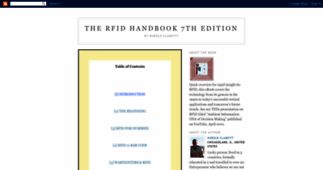The RFID HandBook 7th Edition
Enter a key term, phrase, name or location to get a selection of only relevant news from all RSS channels.
Enter a domain's or RSS channel's URL to read their news in a convenient way and get a complete analytics on this RSS feed.
Unfortunately The RFID HandBook 7th Edition has no news yet.
But you may check out related channels listed below.
[...] of intellectual giants, such as: Michael Faraday: in 1846 identified that both light and radio waves are part of electromagnetic energy. James Maxwell: in 1864 propounded his theory that electric [...]
[...] unique objects, processes, transactions or events. RFID does this by using a burst of radio waves to move information. It is possible to explain RFID using only two basic building blocks - Tag [...]
[...] are correlated: the higher the frequency, the shorter the wavelength. To translate this to radio waves imagine the ocean waves traveling at an enormous speed, the speed of light which is 186,000 [...]
[...] RFID vs BAR CODE To understand RFID's benefits this blog compares its capabilities to an existing industry [...]
[...] use of RFID will be phased in. And in all cases traditional labeling requirements like that of bar code will not be eliminated due to this initiative. DoD’s Initial UHF RFID Roll-out Strategy and [...]
[...] improve decision making. Customers experience the impact of the volume and velocity of RFID information and realize they need to seriously address the data warehousing issues lurking below the [...]
[...] list of constraints is RFID PAPER! Summary Hal’s law means that real time networking of RFID information will raise the benefits of the system while simultaneously reducing costs. Traditional [...]
[...] who last handled a document file. Chapter Source: Texas Instrumeents - The Cutting Edge of RFID Technology and Application for Manufacturing and Distribution by Susy d' Hont. [...]
[...] reducing costs. Traditional notions of marginal rate of productivity for RFID technology will go the way of the dinosaur and increasing returns will evolve and create value [...]
[...] vendors is available. This drives down NRE making it feasible for wide scale adoption of RFID technology into the enterprise. Second, integration with ERP and other systems is rapidly growing due to [...]
[...] to counter theft in retail stores is a prime example of early commercial use of RFID technology. Sensormatic and Checkpoint were founded in the late 1960s to offer this solution. [...]
[...] on ISO RFID STANDARDS: Air Interface Standard for Item Management ISO/IEC 18000-2 LF nominally 132kHz ISO/IEC 18000-3 HF 13.56 MHz [...]
[...] of project timeframes and budget over-runs. Non-recurring engineering is limited to the air interface for issues like EMI (electromagnetic interference) and achieving 100% read rates. All [...]
[...] 0 is accomplished by shifting the peak and trough of the wave forms. These factors make the air interface the most complicated component of system design. In other words, the radio channel is the [...]
[...] so as to ensure performance in these areas plus real time visibility. In that regard, radio frequency identification has been chosen by the Department of Defense as the technology of choice to enhance [...]
[...] for it. The more software and hardware that is available, the more people buy RFID. Radio Frequency Identification: a self fulfilling prophecy at best or a disruptive technology at worst. HAL's LAW I [...]
[...] that totes were ID'd incorrectly. This led to delays and even incorrect delivery of orders. An RFID tag is welded to the bottom of each tote. It is a read only tag with 64 bits of data that represent [...]
[...] Table of Contents [I] INTRODUCTION [2] THE BEGINNING [3] RFID FOR DUMMIES [4] RFID vs BAR CODE [5] WARFIGHTERS & RFID [6] EINSTEIN'S THEORY OF RFID [7] SYSTEM [...]
[...] RFID FOR DUMMIES Radio Frequency identification - RFid, the technology of tomorrow, is here today. In fact, [...]
[...] of intellectual giants, such as: Michael Faraday: in 1846 identified that both light and radio waves are part of electromagnetic energy. James Maxwell: in 1864 propounded his theory that electric [...]
[...] unique objects, processes, transactions or events. RFID does this by using a burst of radio waves to move information. It is possible to explain RFID using only two basic building blocks - Tag [...]
[...] are correlated: the higher the frequency, the shorter the wavelength. To translate this to radio waves imagine the ocean waves traveling at an enormous speed, the speed of light which is 186,000 [...]
Related channels
-
7th Pay Commission
central government employee news
-
Prudential Custom Employee Handbooks
Custom Employee Handbooks
-
Edit photo
photo editing, free photo edit, edit photo, photoshop, download, photoshop-editphoto.blogspot

